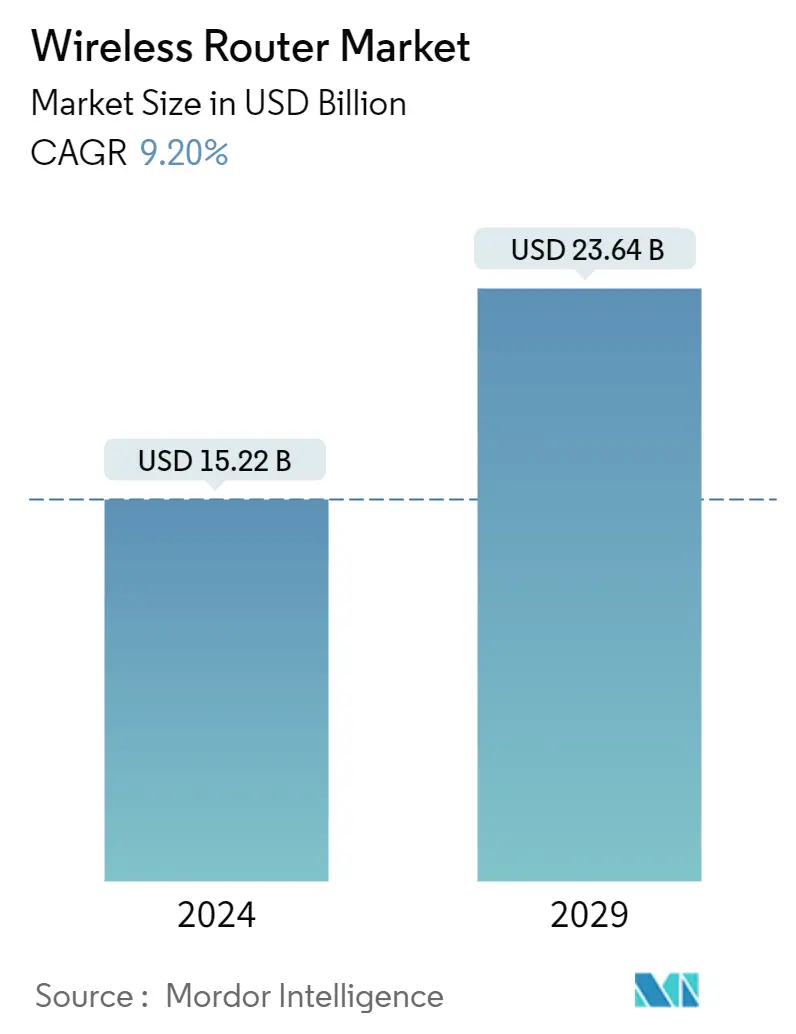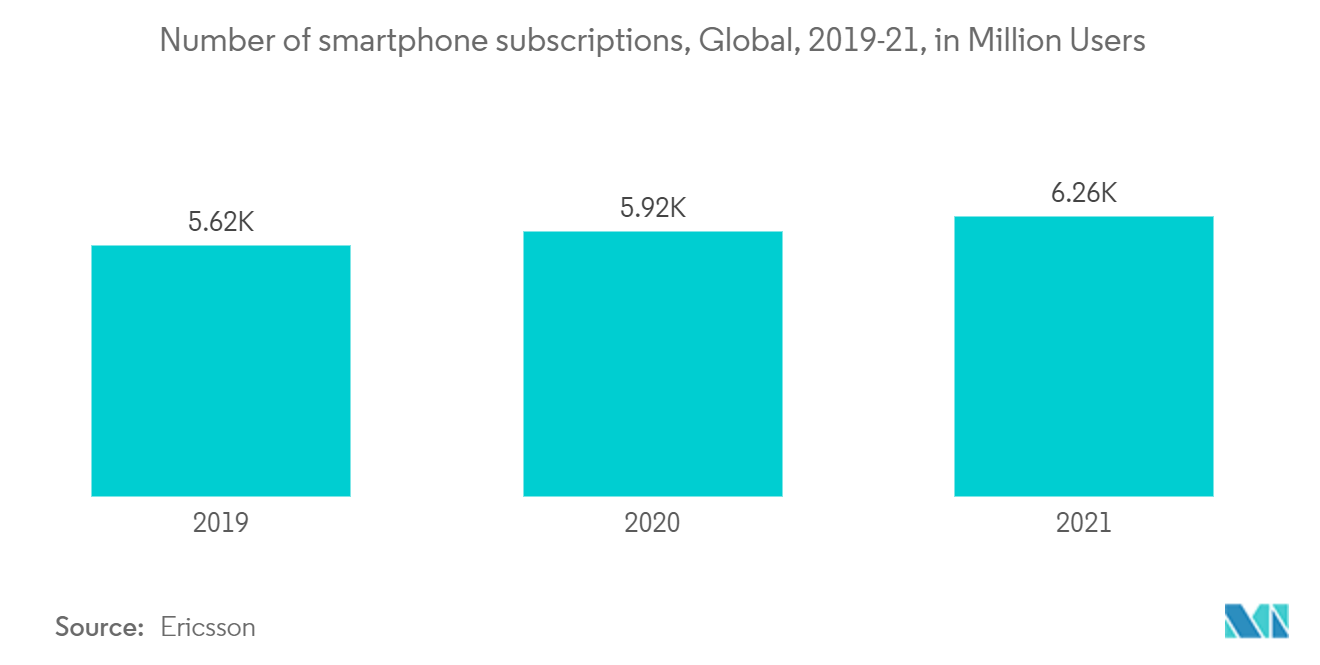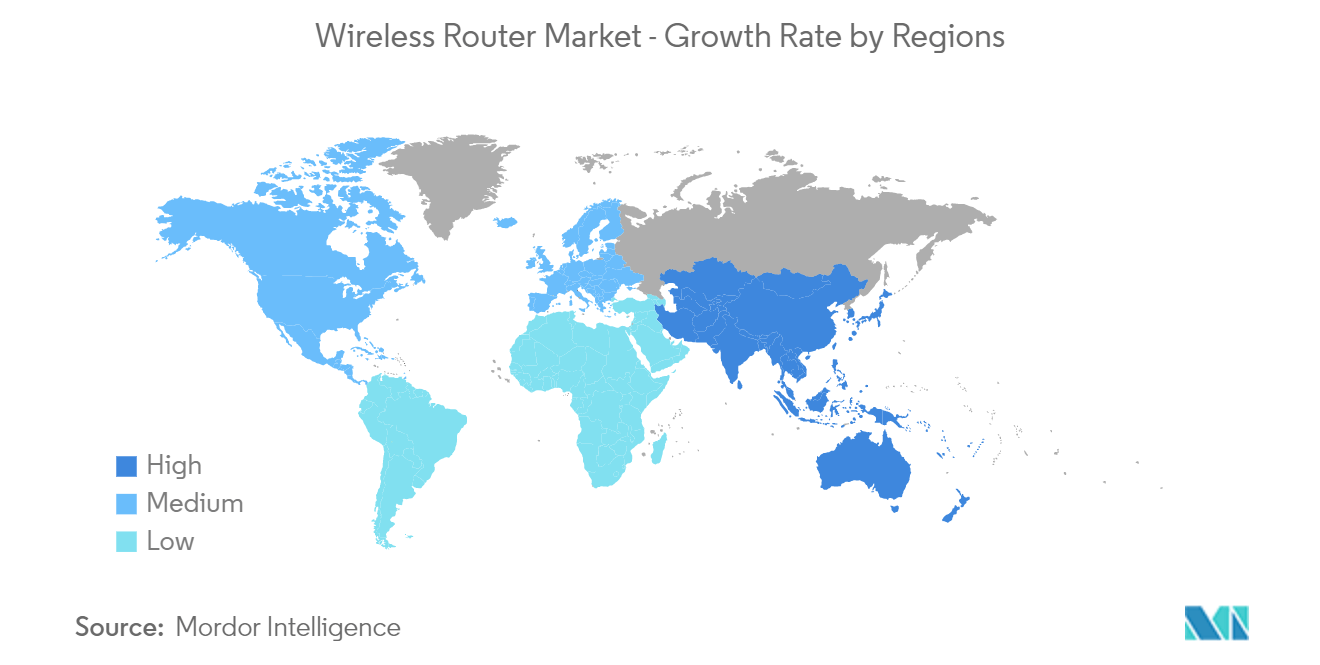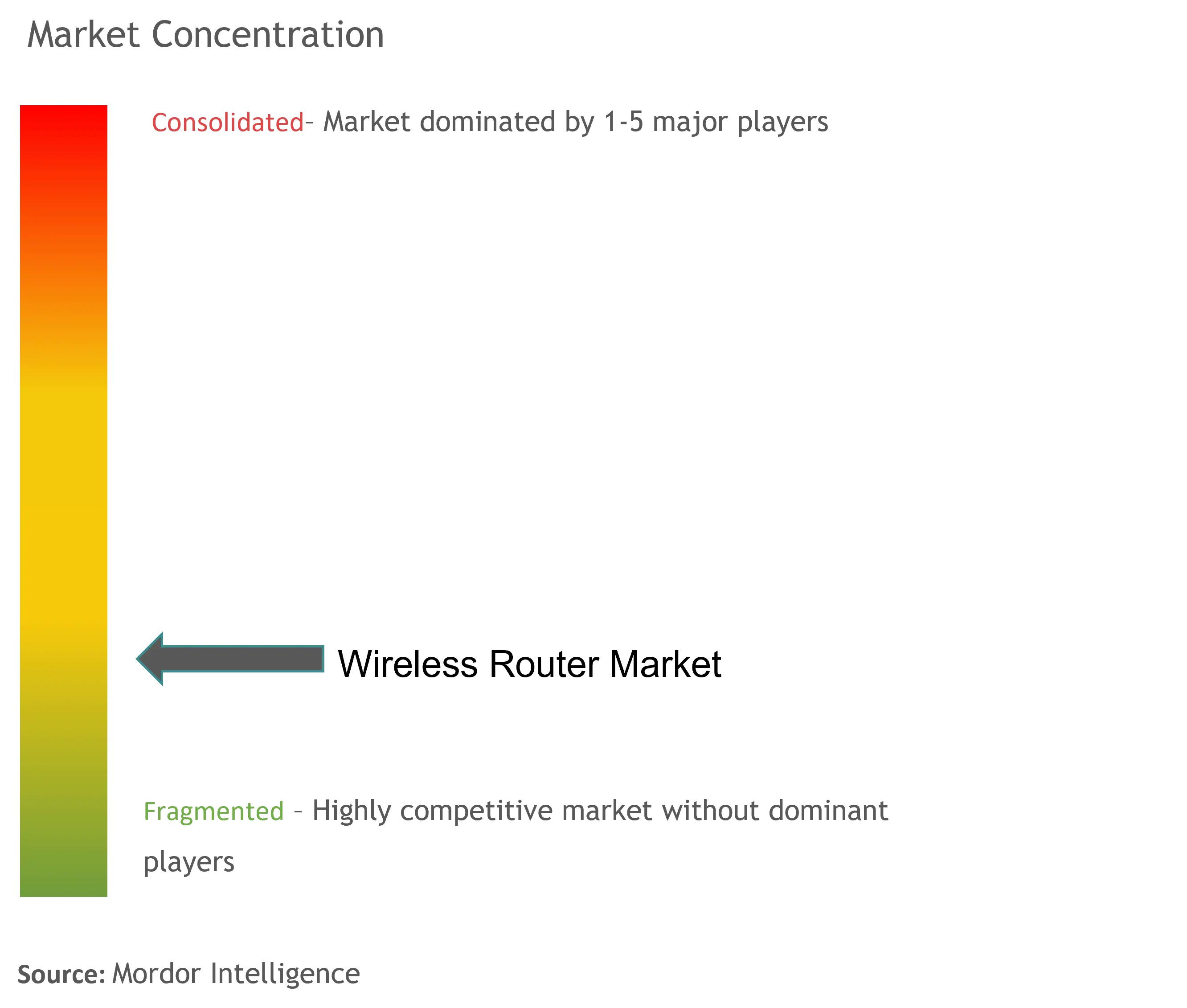Wireless Router Market Size

| Study Period | 2021 - 2029 |
| Market Size (2024) | USD 15.22 Billion |
| Market Size (2029) | USD 23.64 Billion |
| CAGR (2024 - 2029) | 9.20 % |
| Fastest Growing Market | Asia Pacific |
| Largest Market | North America |
Major Players
*Disclaimer: Major Players sorted in no particular order |
Wireless Router Market Analysis
The Wireless Router Market size is estimated at USD 15.22 billion in 2024, and is expected to reach USD 23.64 billion by 2029, growing at a CAGR of 9.20% during the forecast period (2024-2029).
With work-from-home (WFH) becoming the trend during the COVID-19 pandemic, players and individual consumers needed to secure various IT products for their employees. As a result, supplies of IT peripherals, including wireless routers, witnessed an increase in demand.
Wireless routers are known for including wireless access points that are used to provide access to the internet or a private computer network. Depending on the manufacturer and model, wireless routers function in a wired local area network, wireless-only LAN, or the mixed wired and wireless network.
The primary factor for the growth of wireless technology is the regularly changing standards set for improving routers. Wireless router technology has evolved steadily over the past decade, keeping pace with advances in standards set by the Institute of Electrical and Electronics Engineers (IEEE). These standards are updated regularly to improve network throughput in terms of maximum speeds and transmission capabilities.
These upgrades have given the companies in the market the means to strive for innovation and successfully satisfy the customers' demand for higher bandwidth and faster internet. The key market drivers are increasing consumer demand for web-enabled devices and growth in IP traffic.
The increasing demand for faster internet connectivity among consumers deteriorated due to the increase in the number of effective devices being connected. It is spurring the demand for wireless routers with appropriate connectivity. Further, the advent of IoT and changing consumer preferences toward purchasing various gadgets and wearables capable of operating and performing a plethora of functions with internet connectivity are expected to propel the growth of the wireless router market over the forecast period.
For businesses, the priorities differ from most consumer users. Security, support, remote access, business-grade VPN, WAN redundancy, connectivity options, and scalability are ranked higher than absolute raw speed, value for money, or quality of service. Moreover, companies are introducing new products and strategizing to expand to leverage the market's growing demand. For instance, in November 2022, DIGISOL Systems Ltd, a provider of Trusted Made In India Products and IT Networking Solutions, announced the launch of DG-GR6821AC - Digisol XPON ONU 1200 Mbps Wi-Fi Router with 1 PON, 2 GE Port & 1 FXS Port.
COVID-19 has accelerated the shift toward increased usage of wireless technology. The industry has responded well to this increased demand, which, in turn, has created an opportunity for new technologies to be deployed in the markets, such as data centers, cloud, gaming, hardware, and connected devices.
Wireless Router Market Trends
This section covers the major market trends shaping the Wireless Router Market according to our research experts:
The Residential Sector is Expected to Record Significant Adoption
The demand for the internet among various households has been increasing with the increase in connected devices. According to Ericsson Mobility Report 2021, by the end of 2026, the company estimates 3.5 billion 5G subscriptions globally, accounting for around 40% of all mobile subscriptions. Such developments are expected to rapidly increase the number of connected devices in residential environments.
A majority of households are being transformed into smart homes that require the internet to facilitate many functions. The advent of smart TVs, and smart speakers, such as Amazon Echo and Google Home, boosted the growth of the wireless router market.
Further, with local schools moving to remote learning and more parents working from home due to COVID-19 concerns, internet providers have noticed a shift in usage. Internet providers are aiming to capitalize on this opportunity.
In September 2022, ExpressVPN launched its first router, Aircove, with a built-in VPN and Wi-Fi 6 consumer router. The router offers users easier home-wide privacy protection. Aircove's coverage range is up to 1,600 square feet, and its onboard VPN allows unlimited simultaneous connections. The device permits to speed-up of 600 Mbps for 2.4GHz bands and 1,200 Mbps for 5GHz.

The United States in North America is Expected to Hold Major Share
Globally, the United States is one of the most mature markets for fixed broadband internet connections. According to ITU, In 2021, approximately 90% of individuals in the United States had internet access. The United States is one of the biggest online markets in the world. Such a huge population using the internet is expected to boost the demand for wireless routers in the United States over the forecast period.
The presence of major technological giants, such as Cisco, D-Link, and TP-Link, coupled with the high adoption of technological trends in the country, boosts the market for wireless routers. Moreover, the fixed broadband market is mature. It is nearing saturation, with more than three out of every four US households expected to have a fixed broadband connection over the forecast period.
In February 2022, D-Link announced the launch of an AI-powered Wi-Fi router, the Eagle Pro AI series, to boost internet speed. It includes R15 EAGLE PRO AI AX1500 Smart Router, M15-2PK, and M15-3PK EAGLE PRO AI AX1500 Mesh Systems, and E15 AX1500 Mesh Range Extender.
Consumer demand for fixed broadband access is expected to record sluggish growth. However, due to the impact of mobile broadband services, the market is expected to witness growth over the forecast period, resulting in more than 3.3 million fixed broadband subscriptions. Furthermore, the increasing adoption of smart homes, with 30 million US households already being smart homes, is also favoring the conditions for wireless routers.

Wireless Router Industry Overview
The wireless router market is highly competitive, with several major players. In terms of market share, few major players currently dominate the market. The major players with prominent shares in the market are focusing on expanding their customer base across foreign countries. These companies leverage strategic collaborative initiatives to increase their market share and profitability. The companies operating in the market are also acquiring start-ups working on wireless router technologies to strengthen their product capabilities.
In September 2022, D-Link announced the launch of its new EAGLE PRO AI M32 range. The product comes with a 2-pack (M32-2PK) or 3-pack (M32-3PK) system and features the latest Wi-Fi 6 technology. Users of the new D-Link M32 Mesh Systems also experience dual-band AX3200 802.11AX combined wireless speeds of up to 3.2 Gbps.
In September 2022, ASUS announced the launch of RT-AXE7800, a Wi-Fi 6E router, offering up to 7800 Mbps of bandwidth and robust network security. It is made to expand the connectivity requirements of individuals who need to manage many devices, such as hybrid workers and professional studios.
Wireless Router Market Leaders
-
ASUSTeK Computer Inc.
-
Netgear Inc.
-
D-Link Corporation
-
Huawei Technologies Co. Limited
-
Xiaomi Inc.
*Disclaimer: Major Players sorted in no particular order

Wireless Router Market News
- August 2022 - ASUS Republic of Gamers (ROG) introduced the ROG Rapture GT-AX11000 Pro, a gaming router that would deliver ultrafast Wi-Fi 6 and 10 Gbps Ethernet to every type of gamer. Its two 5 GHz bands and one 2.4 GHz band are fully backward-compatible with older Wi-Fi devices, while newer ones can utilize the advanced technology to improve connection speeds and signal strength.
- January 2022 - TP-Link, a provider of consumer and business networking products, announced the launch of Aginet, a solution for internet service providers. Under the Aginet flag, TP-Link will release a comprehensive range of products and solutions, including Wi-Fi routers, Whole Home Mesh Wi-Fi, GPON OLT, GPON Wi-Fi routers, VDSL modem routers, and 4G/5G routers.
Wireless Router Market Report - Table of Contents
1. INTRODUCTION
- 1.1 Study Assumptions and Market Definition
- 1.2 Scope of the Study
2. RESEARCH METHODOLOGY
3. EXECUTIVE SUMMARY
4. MARKET INSIGHT
- 4.1 Market Overview
- 4.2 Wi-Fi Architecture and Technology Evolution
-
4.3 Industry Attractiveness - Porter's Five Forces Analysis
- 4.3.1 Bargaining Power of Suppliers
- 4.3.2 Bargaining Power of Consumers
- 4.3.3 Threat of New Entrants
- 4.3.4 Intensity of Competitive Rivalry
- 4.3.5 Threat of Substitutes
- 4.4 Assessment of Impact of COVID-19 on the Industry
5. MARKET DYNAMICS
-
5.1 Market Drivers
- 5.1.1 Growth in Internet Traffic and Increasing Consumer Demand for Internet-enabled Devices
- 5.1.2 Exponential increase in the bandwidth Requirements Across Enterprises Owing to Digitization
-
5.2 Market Restraints
- 5.2.1 Network Security and Complexities Related to Network Management
- 5.2.2 Susceptibility to Macro-economic Changes
- 5.2.3 Usage of Mobile Broadband
6. MARKET SEGMENTATION
-
6.1 By Component Type
- 6.1.1 By Wi-Fi Band
- 6.1.1.1 Single Band
- 6.1.1.2 Dual Band
- 6.1.1.3 Tri Band
-
6.2 By End-user Industry
- 6.2.1 Residential
- 6.2.2 Business/Commercial
- 6.2.2.1 BFSI
- 6.2.2.2 Education
- 6.2.2.3 Healthcare
- 6.2.2.4 Media and Entertainment
- 6.2.2.5 Other End-user Industries
-
6.3 Geography
- 6.3.1 North America
- 6.3.1.1 United States
- 6.3.1.2 Canada
- 6.3.2 Europe
- 6.3.2.1 United Kingdom
- 6.3.2.2 Germany
- 6.3.2.3 France
- 6.3.2.4 Spain
- 6.3.2.5 Rest of Europe (Italy, Nordics)
- 6.3.3 Asia-Pacific
- 6.3.3.1 China
- 6.3.3.2 Japan
- 6.3.3.3 India
- 6.3.3.4 Rest of Asia-Pacific (South Korea, Southeast Asia, and ANZ)
- 6.3.4 Latin America (Mexico, Brazil, and Argentina, among others)
- 6.3.5 Middle East and Africa (United Arab Emirates, Saudi Arabia, and South Africa, among others)
7. COMPETITIVE LANDSCAPE
-
7.1 Company Profiles*
- 7.1.1 D-Link Corporation
- 7.1.2 Belkin International Inc.
- 7.1.3 TP-Link Technologies Co. Limited
- 7.1.4 Netgear Inc.
- 7.1.5 Huawei Technologies Co. Limited
- 7.1.6 ASUSTeK Computer Inc.
- 7.1.7 Xiaomi Inc.
- 7.1.8 Mercury-PC
- 7.1.9 Buffalo Americas Inc.
- 7.1.10 Edimax Technology Co. Limited
- 7.1.11 Amped Wireless
- 7.1.12 Cisco Systems Inc.
- 7.1.13 Linksys Holdings Inc.
8. INVESTMENT ANALYSIS
9. FUTURE OF THE MARKET
** Subject To AvailablityWireless Router Industry Segmentation
A wireless router is a device that provides access to the internet or computers, laptops, and tablets, to a network. It allows users to share an internet connection, files, or printers in a local area network (LAN). Moreover, a wireless router connects a LAN to a wide area network (WAN), such as the internet. A wireless router largely eliminates the need for awkward, unsightly wires and allows multiple users to connect to a LAN and WAN.
The wireless router market is segmented by component type (Wi-Fi band (single, dual, and tri-band)), end user (residential and commercial (BFSI, education, healthcare, media, and entertainment)), and geography.
The market sizes and forecasts are provided in terms of value (in USD million) for all the above segments.
| By Component Type | By Wi-Fi Band | Single Band |
| Dual Band | ||
| Tri Band | ||
| By End-user Industry | Residential | |
| Business/Commercial | BFSI | |
| Education | ||
| Healthcare | ||
| Media and Entertainment | ||
| Other End-user Industries | ||
| Geography | North America | United States |
| Canada | ||
| Geography | Europe | United Kingdom |
| Germany | ||
| France | ||
| Spain | ||
| Rest of Europe (Italy, Nordics) | ||
| Geography | Asia-Pacific | China |
| Japan | ||
| India | ||
| Rest of Asia-Pacific (South Korea, Southeast Asia, and ANZ) | ||
| Geography | Latin America (Mexico, Brazil, and Argentina, among others) | |
| Middle East and Africa (United Arab Emirates, Saudi Arabia, and South Africa, among others) |
Wireless Router Market Research FAQs
How big is the Wireless Router Market?
The Wireless Router Market size is expected to reach USD 15.22 billion in 2024 and grow at a CAGR of 9.20% to reach USD 23.64 billion by 2029.
What is the current Wireless Router Market size?
In 2024, the Wireless Router Market size is expected to reach USD 15.22 billion.
Who are the key players in Wireless Router Market?
ASUSTeK Computer Inc., Netgear Inc., D-Link Corporation, Huawei Technologies Co. Limited and Xiaomi Inc. are the major companies operating in the Wireless Router Market.
Which is the fastest growing region in Wireless Router Market?
Asia Pacific is estimated to grow at the highest CAGR over the forecast period (2024-2029).
Which region has the biggest share in Wireless Router Market?
In 2024, the North America accounts for the largest market share in Wireless Router Market.
What years does this Wireless Router Market cover, and what was the market size in 2023?
In 2023, the Wireless Router Market size was estimated at USD 13.94 billion. The report covers the Wireless Router Market historical market size for years: 2021, 2022 and 2023. The report also forecasts the Wireless Router Market size for years: 2024, 2025, 2026, 2027, 2028 and 2029.
WiFi Router Industry Report
Statistics for the 2024 WiFi Router market share, size and revenue growth rate, created by Mordor Intelligence™ Industry Reports. WiFi Router analysis includes a market forecast outlook to 2029 and historical overview. Get a sample of this industry analysis as a free report PDF download.



